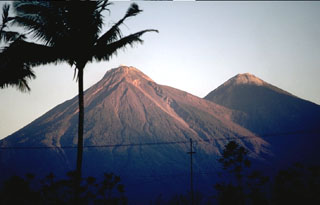Report on Fuego (Guatemala) — 4 June-10 June 2025
Smithsonian Institution / US Geological Survey
Weekly Volcanic Activity Report, 4 June-10 June 2025
Managing Editor: Sally Sennert.
Please cite this report as:
Global Volcanism Program, 2025. Report on Fuego (Guatemala) (Sennert, S, ed.). Weekly Volcanic Activity Report, 4 June-10 June 2025. Smithsonian Institution and US Geological Survey.
Fuego
Guatemala
14.4748°N, 90.8806°W; summit elev. 3799 m
All times are local (unless otherwise noted)
The Instituto Nacional de Sismología, Vulcanologia, Meteorologia e Hidrología (INSIVUMEH) reported that elevated activity at Fuego on 4 June was characterized by lava fountaining, dense ash plumes, and pyroclastic density currents (PDCs). In a statement issued at 2030 on 4 June INSIVUMEH noted that there was a shift in eruption style to more effusive activity with abundant gas emissions and the ejection of incandescent material that covered the entire crater area and upper W flank. Lava fountaining became continuous, constant avalanches of material descended the flanks, and lava descended the Seca-Santa Teresa drainage (W) as far as 600 m. The activity continued through the night.
Just before 0500 on 5 June weak-to-moderate PDCs descended the Seca, Ceniza (SSW), and Las Lajas (SE) drainages. During 0500-1105 several more moderate-to-strong PDCs mainly descended the Las Lajas drainage, but also the Seca and Ceniza drainages, to as far as 7 km. Ash plumes rose from the summit and rose several hundred meters along the PDC tracks and drifted SW, W, and NW. Ashfall was reported in the municipalities of Acatenango (8 km E) and San Pedro Yepocapa (8 km NW) according to the Coordinadora Nacional para la Reducción de Desastres (CONRED). The Ministry of Environment and Natural Resources (SE-CONRED) issued an Orange Alert for the municipality of San Juan Alotenango and the municipality of Gimnasio. Ash plumes drifted as far as 60 km W and SW. By 1230 PDCs were also descending the La Trinidad (SSW) drainage. SE-CONRED announced that an Orange Alert was extended to the departments of Sacatepéquez, Chimaltenango, and Escuintla and classes were suspended at 43 schools in those departments. At around 1525 lahars that were possibly hot descended the El Jute (ESE) and Las Lajas drainages carrying tree branches, trunks, and blocks possibly as large as 3 m in diameter. By 1600 lahars were traveling down the Ceniza, Zarco, and Mazate rivers and again carried tree branches, trunks, volcanic material, and blocks possibly as large as 3 m in diameter. During the next hour additional lahars descended the Seca and Mineral (W) drainages, tributaries of the Pantaleón River. CONRED coordinated with Instituto Privado de Investigacio´n sobre Cambio Clima´tico (ICC) to evacuate about 600 residents in Panimaché I and II (8 km SW), El Rodeo (10 km SSE), Trinidad (21 km SE), and Morelia (9 km SW), though a news article noted that 700 had evacuated. A section of the National Route 14 (RN-14) was closed.
In a special report issued at 1925 On 5 June INSIVUMEH reported that PDCs continued to travel up to 7 km down multiple drainages. Ash-and-gas plumes from the PDCs rose several hundred meters high and drifted NW, W, and SW. By 0015 on 6 June a lava flow in the Ceniza drainage was 1.2 km long. Incandescent material on the SW flank was visible in webcam images. Ash from the descent of PDCs was not visible due to weather clouds around the volcano. Incandescent material was periodically ejected above the summit and landed on the flanks about 30 m from the crater rim. CONRED reported that activity significantly decreased during the early morning, after about 30 hours of the generation of lava flows, PDCs, and ash plumes. Incandescent material was no longer being ejected above the summit and ash was no longer suspended in the atmosphere based on webcam images.
During 6-7 June the seismic network recorded 4-6 explosions per hour. Ash-and-gas plumes rose as high as 1.1 km above the summit and drifted 10-30 km SW. Some explosions generated rumbling and shock waves. Incandescent material was ejected 200 m above the summit. Explosions during 8-9 June generated ash plumes that rose around 700 m above the summit and drifted 25 km W and SE. The explosions produced rumbling and shock waves, and generated block avalanches around the summit area and down various drainages. Weather clouds obscured views during 9-10 June, though infrasound instruments detected 2-8 explosions per hour. Faint sounds of blocks descending the flanks were reported and webcams captured incandescent blocks descending the Seca, Ceniza, and Las Lajas drainages. Ashfall was reported in several communities to the SW, including San Pedro Yepocapa, Panimaché I and II, Morelia, Santa Sofía (12 km SW), Los Yucales (12 km SW), and El Porvenir (8 km ENE).
Geological Summary. Volcán Fuego, one of Central America's most active volcanoes, is also one of three large stratovolcanoes overlooking Guatemala's former capital, Antigua. The scarp of an older edifice, Meseta, lies between Fuego and Acatenango to the north. Construction of Meseta dates back to about 230,000 years and continued until the late Pleistocene or early Holocene. Collapse of Meseta may have produced the massive Escuintla debris-avalanche deposit, which extends about 50 km onto the Pacific coastal plain. Growth of the modern Fuego volcano followed, continuing the southward migration of volcanism that began at the mostly andesitic Acatenango. Eruptions at Fuego have become more mafic with time, and most historical activity has produced basaltic rocks. Frequent vigorous eruptions have been recorded since the onset of the Spanish era in 1524, and have produced major ashfalls, along with occasional pyroclastic flows and lava flows.
Sources: Instituto Nacional de Sismologia, Vulcanologia, Meteorologia, e Hidrologia (INSIVUMEH), Coordinadora Nacional para la Reducción de Desastres (CONRED), TV Azteca Guate

